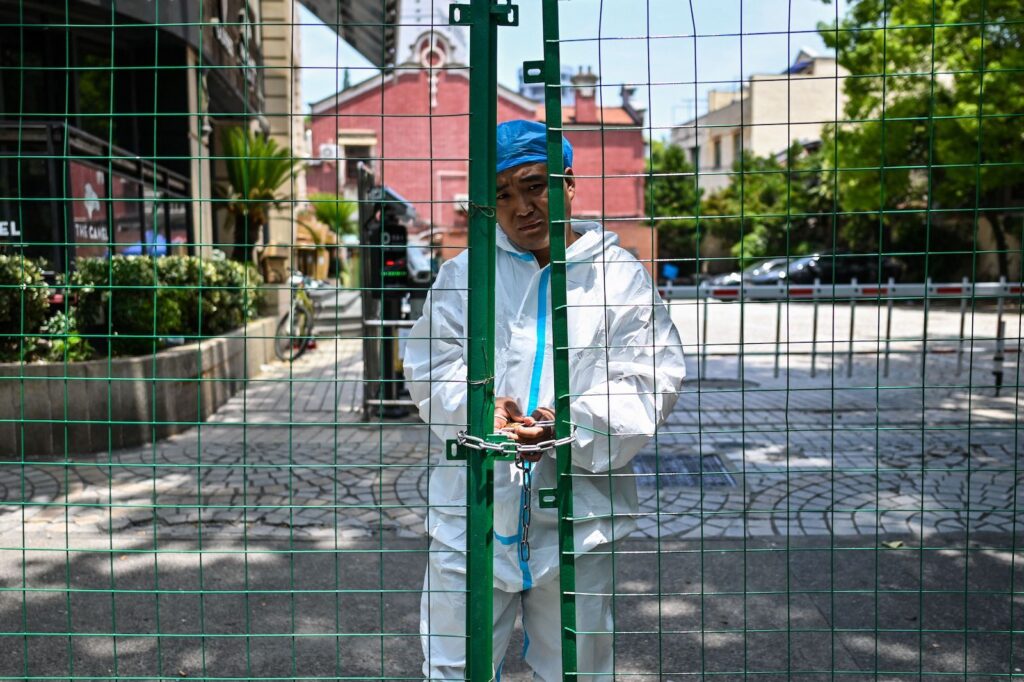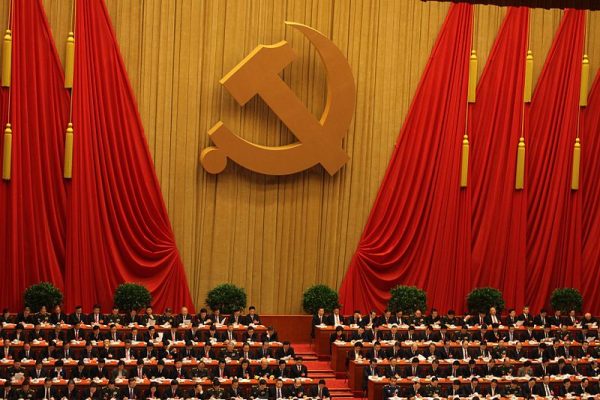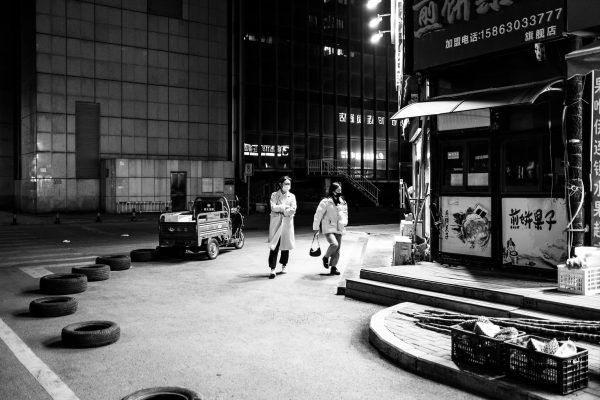This essay appears in print in Imagining Global Futures.
For a few days in April, my timeline was dominated by images of a ninety-five-year-old woman in Shanghai battling with the “Big Whites”—government workers and cops clad in hazmat suits who have come to symbolize the coercive excesses of the megacity’s recent COVID-19 lockdown. Wielding nothing more than a broom, the woman beat back the advances of six police officers who had come to take her from her home to the much-feared centralized quarantine facilities. Eventually she was subdued and detained, only to appear later that day back at home. She purportedly escaped quarantine by jumping over a wall. Her iron will and fearlessness in the face of overwhelming state power instantly won her cult status on the Internet.
This nonagenarian insurrectionist mirrored 1989’s “tank man,” who stopped a line of tanks in Tiananmen Square. Both individuals stared down the heavy hand of an overbearing dictatorship and forced them to blink, dramatizing the lines of oppression and resistance. The tank man and the Shanghai grandma deserve our admiration, but neither of their actions should be reduced to a Hollywood-style depiction of individual versus the state. In the context of the Chinese state’s unceasing efforts to atomize society, swinging a broom at the Big Whites is a political act, but one that we must situate within a lineage of fierce collective resistance to social death—not only in China, but within the struggles of the dispossessed around the world.
With or without the COVID-19 pandemic, China has maintained a greater capacity to control the internal movement of its population than perhaps any other country in the world. This is primarily enforced through the household registration system (hukou) which has linked the provision of social services to regional locales since 1958. Under Deng Xiaoping, China set about constructing a national labor market, which today allows citizens to enjoy the narrow market freedom to seek employment throughout the country. But social citizenship, including access to state subsidized health care, education, pensions, and housing, is structured at the level of the city.
In recent years the central government has promoted a technocratic biopolitics that aims to specifically distribute people, in just the right qualities and quantities, within a complex socio-spatial hierarchy of cities and regions. This “just-in-time urbanization” is meant to pull elite talents into elite cities and push the “low-end population” to low-end places.
Although human mobility can never be so precisely dictated, the practical effect for China’s internal labor migrants has been a severing of the spaces of life from work. Nearly 300 million people have been displaced, having moved to cities in search of work only to be denied access to life-sustaining infrastructures, such as housing and health care. This division has been enforced via point-based evaluative systems which allow for nominally public resources to be distributed to property-owning people with high levels of education. In other words, while there is free movement of capital and labor within China, there remain massive internal borders restraining social reproduction.
Sometimes these invisible borders manifest physically. Although deporting nonlocals from cities (“custody and repatriation,” in the official jargon) was banned after the 2003 police murder of migrant Sun Zhigang, cities still take coercive measures to remove people deemed out of place. This has involved bulldozing informal schools for migrant children and even razing entire migrant communities. The most spectacular recent example of coercive expulsion of migrant workers came in 2017 when the Beijing municipal government used a tragic fire as pretext for mass evictions and redevelopment of working-class neighborhoods, displacing as many as 100,000 people in the process.
Such coercive interventions arise due to the dissonance between a labor market that is nationally organized and social welfare organized on the regional level, a dynamic that has generated sporadic bursts of social struggle. In my own research with migrant workers in Beijing, Guangzhou, and elsewhere, I frequently found that people were both keenly aware of how cities would collapse without their labor and incredulous that they were welcomed into these cities as workers without access to education, housing, and health care. Often without state support, these communities have creatively strived to meet their own social needs.
As far back as the 1990s, for example, small groups of parents would pool their limited resources to start informal schools, often beginning in a single room of an apartment. Some of these mutual-aid style operations continued to grow in the city’s institutional interstices, providing low-cost education to children denied access to the public system. Without public support these schools certainly face limitations, as they are made to depend on tuition while serving a poor and working-class community. Still, some have managed to gain financial support from foundations and the government, while realizing admirable academic track records. Such efforts have not reversed the tide of educational and economic inequality in China, but they have, at a minimum, allowed millions of migrant workers to live in the same city as their children.
Some have also found institutional workarounds in their search for affordable housing in the booming cities. Particularly in “tier one” megacities, such as Shanghai, Beijing, Shenzhen, and Guangzhou, the cost of housing is astronomical, and purchasing an apartment is out of reach for all but a tiny number of rural-to-urban migrants. These workers have often found housing in “villages in the city”—land formally designated as rural that has been enveloped by the city over the past several decades of breakneck urbanization. The local communities who maintain use rights to this land have constructed relatively low-cost informal housing. As with informal schools, there are real limitations: absent public support, the housing is often shoddy, with poor access to physical and social infrastructure. Nonetheless, this housing allows migrants’ access to the urban labor market that would otherwise be blocked by high housing costs.
These survival tactics are legally precarious and therefore exposed to the whims of local officials considering redevelopment. But time and again we have seen migrants in Chinese cities demand a right to stay. In Beijing, for example, at least seventy-six schools for migrant children were demolished between 2010 and 2018. School demolitions frequently generated confrontational collective action, including petitioning government officials, road blockades, and even parents self-immolating. These bouts of unrest have frequently been able to wrest victories, beating back plans for demolition and winning enrollments for children in public schools, even as the exclusivity of China’s wealthy megacities marches on.
Migrant communities also fought against Beijing’s informal housing evictions in the fall of 2017. Their resistance not only generated widespread sympathy from urban citizens, but also substantive cross-class solidarity. Beijingers from all walks of life organized through mutual aid networks to provide temporary housing, clothing, and food to the tens of thousands who were displaced. Prominent academics signed onto a letter denouncing the evictions. In the context of dramatically reduced academic freedom under Xi Jinping, such a letter carried great risk as well as symbolic weight. Less altruistically but nonetheless significantly, some of the companies that depended on migrant workers rushed to organize temporary housing. A broad coalition arose nearly overnight to resist an urban state endowed with the biopolitical machinery to reorganize human life as they saw fit. Migrant struggles to bring work and life closer took on a new and even more urgent character in the following years.
The initial COVID-19 outbreak and subsequent lockdown of Wuhan revealed much about the state’s population management regime. As meticulously documented in Chuang’s Social Contagion (2021), the lockdown’s success cannot be attributed to an omnipotent centralized state. In fact, it was precisely the state’s incapacity and irrationality that allowed the virus to spread in the first place. Rather, dense networks of mutual aid sprang into action during the initial outbreak, facilitating the movement of essential goods throughout the city and region, and thereby allowing most people to stay home. Although the state did eventually commit to eradicating the virus, the key to success in Wuhan was the state’s coordinative capacities combined with bottom-up initiatives.
In the two-and-a-half years since its start, the pandemic has dramatically reshaped human mobility. At the most general level, the COVID-19 era has widened the mobility gap between capital and commodities, and labor and people. Without a doubt, the movement of commodities has been upended by what has somewhat imprecisely been referred to as a supply chain crisis. Nonetheless, while global immigration and international travel fell markedly due to the pandemic, global trade hit a new record of $28.5 trillion in 2021. China’s trade with the United States increased by 25 percent in 2021, while its global trade surplus hit a record of $676.6 billion. At the same time, China imposed radical new mobility controls on people, both internationally and domestically.
China’s approach to managing human movement during the pandemic cannot be viewed in isolation from the rest of the world. For most of 2020 and 2021, government officials and media crowed about the catastrophic failure of most other countries—but especially the United States—to prevent mass death. Many Chinese people justifiably took pride in, and actively supported, the state’s efforts to keep the virus at bay, thereby allowing for a high degree of normality in daily life. Xi’s narrative of the “great revival of the Chinese nation” in contrast to the decline of the West was buoyed by their disparate responses to the pandemic.
But by the spring of 2022, the virus had mutated and home-grown vaccines became nearly useless in preventing infection (although, with three doses, still highly effective against hospitalization and death). China and perhaps North Korea were left as the last “zero COVID-19” holdouts.
When cases began to emerge in Shanghai in March, few could anticipate the social catastrophe that was about to unfold. Following the “dynamic zero” playbook, the initial response was not a citywide lockdown, but more targeted quarantines at the community-level administrative units. On March 28 the government announced a staged lockdown, beginning in the eastern portion of the city before expanding to the western districts. Residents were told to expect just a few days of lockdown. But as days dragged into weeks, the zealously enforced lockdown produced all manner of human suffering. Mental health issues induced from isolation led to suicides; tightly controlled and often poorly coordinated food systems collapsed, leaving people without adequate sustenance; health care for other illnesses was upended.
A key distinction between Wuhan and Shanghai is that, during the most recent lockdown, the state insisted that people continue to work. Striving to maintain the circulation of capital while radically demobilizing labor is a challenge, but the Shanghai authorities were willing to try. The key spatio-political weapon in their arsenal was the closed loop. Not totally dissimilar from the NBA’s “bubble” of 2020, the closed loop was initially deployed in the 2022 Beijing Winter Olympics to allow for people to gather from all over the world without increasing infection rates in the broader society. The strategy was to keep the facilities as close to hermetically sealed as possible, only allowing essential items such as food and medicine to enter, while preventing nearly everyone from leaving the loop. This strategy allows capital to circulate while reducing human mobility to an absolute minimum.
By the arrival of the Shanghai lockdown later that spring, it became apparent that the logic of the closed loop had seeped out of the Olympic village and into the broader polity. On April 11 the Shanghai government issued a “white list” of 666 companies that could reopen despite the broader lockdown (another 342 companies were added in May). Among those listed were the Tesla Gigafactory and Quanta, one of Apple’s most important assemblers. Closed loop manufacturing required that workers enter the factory and stay there—eating, sleeping, and working solely within the grounds of the plant. When workers were brought into the loop, they had no way of knowing when they would be allowed to leave. Rather than work from home, these workers were being asked to live from work.
Meanwhile the work-from-home regime that white collar workers endured was in essence a closed loop organized at the level of the household. Different communities experienced different intensities of lockdown beginning in March, but in the most extreme cases, people were not allowed outside the doors of their apartments. Food came in via government channels, so-called “group purchasing” (i.e., members of a single community buying products in bulk), or online delivery services which were intermittently available for those who could afford them. Exit from the home-based loop was tightly policed and required official permission. In some cases, zealous officials built literal walls in front of apartment exits to regulate residents’ movement. Urban citizens, many wealthy, faced food shortages and anxiety as they were told to continue with their jobs, childcare, and other forms of labor while living under practical house arrest.
Living at work and working from home superimposed spaces of production and social reproduction to deleterious effect. But many of Shanghai’s poor and working-class residents don’t fit into either of these closed loops. They primarily live in informal housing and work informal jobs. Many live in “group rentals,” often exceeding the legal occupancy, as a way of securing shelter in Shanghai’s exorbitantly expensive real estate market. Others reside in self-constructed housing that does not have legal standing. These populations, residing outside the state’s purview, often did not receive adequate food distributions during the lockdown, leaving them to buy their own food while facing price gouging. The challenge of buying market-rate food was compounded by the fact that these people’s occupations—as construction workers, cooks and waiters, domestic workers, and sex workers—were closed by the lockdown, which typically meant that they had little or no income. Most of these workers are also rural-to-urban migrants who were prevented from leaving Shanghai to go back to their hometowns during the lockdown. The consequence was looming subsistence crisis for vast swathes of the megacity’s underclass.
Lockdowns, a policy that successfully preserved life over the first two years of the pandemic, capsized into interventions that disregard broader social and public health consequences. The “zero COVID-19” strategy cannot be dismissed out of hand, as China has poor vaccination rates among its elderly and woefully inadequate medical facilities and health insurance, particularly for migrant workers. Allowing the virus to spread unchecked would indeed result in mass death. But the strategy does not account for the social needs of the population, while simultaneously exposing migrants and other informal workers to extreme precarity and subsistence crises. The state lost the good will of a society that knows these measures are no longer for the public good, as they are being asked to continue working for capital in the closed loop of their homes, offices, or factories.
Out of such bleak and total forms of control, the heroic protests of Shanghai’s citizens allow us to trace a potential trajectory of social liberation. This impulse was first signaled by a riot that took place on May 5 at Apple supplier Quanta Computer. Although details of the event are still blurry, we know that hundreds of workers fought with guards and breached a checkpoint outside of the factory. Some reports held that workers were fed up with strict virus prevention measures and had been told that they would be unable to return to their dormitories. Others mentioned that they wanted to get out to be able to purchase their own provisions, perhaps dissatisfied with whatever had been delivered to them in the factory. Later in May there was another violent confrontation when a group of workers charged managers’ dormitories over a pay dispute. Weeks of living from work had pushed workers to the breaking point. They needed to escape the loop.
Overt resistance among white collar workers in work-from-home arrangements has been more muted, as the possibility of public collective action has been foreclosed by the lockdown. Nonetheless, myriad forms of resistance have emerged. Wailing and singing from high rise apartments was one way residents collectively commiserated, although some were subsequently met with flying drones ordering them to “control your soul’s desire for freedom.” A devasting video recounting key events in the April lockdown with short audio vignettes captured the imaginations of millions, who reposted it with such frequency that it temporarily overcame China’s mighty censorship apparatus. And countless clips have appeared of people in their homes and in front of their apartments refusing the mandates of social death from overweening Big Whites, including of course the ninety-five-year-old heroine.
Those outside of closed loops also had their grievances and forms of resistance. The outskirts of Shanghai witnessed food riots, as many demobilized migrant workers situated in informal housing had gone weeks without either income or government-provided supply deliveries. In at least one case, people commandeered the cargo from a vegetable truck, tossing the contents freely out to the gathered crowd.
While these struggles for biological and social survival are of course shaped by the particularities of the lockdown, there is a coherent thread that connects them to pre-COVID-19 actions by marginalized migrants: the demand for the relative proximity of life and work. Pre-COVID-19, rural migrants had come to the city to seek wage labor as means of survival, as they simply could not meet their needs by staying on the farm. But given China’s subnational citizenship regime, efforts to relocate social reproduction to the city faced constant obstacles and expulsions. Migrant communities then endeavored to construct a social world, including schools and housing, in relative proximity to their spaces of work. Shanghai’s lockdown represents the spatial inverse, while expressing the same political logic. Rather than severing spaces of work and life, the closed loop collapses the two, such that all processes of reproduction are supposed to happen within the workplace. Relative proximity of work and life means that the two should not be in the same boundaries. The closed loop cuts workers off from any meaningful social life and reduces them to bare labor power. But workers resisted this effort to impose dictatorial control over bodily movement while demanding productivity for capital. People would not be kept alive merely as living labor for the boss.
The most dramatic instance of collective resistance to the closed loop erupted in the fall. In the months after the Shanghai debacle, sporadic lockdowns in response to COVID-19 outbreaks continued in cities including Beijing, Chengdu, and Shenzhen. As the damage to the economy began to take a real toll, hope spread that the government might consider a new path forward. Rumors circulated that after Xi secured an unprecedented third term as China’s leader at October’s Twentieth Party Congress, he would feel confident enough to chart a different course on pandemic control. Those rumors were soon revealed to be wishful thinking, as the Congress saw Xi reemphasize unwavering commitment to zero COVID-19.
Perhaps even before the Congress concluded, the virus began circulating in the metropolis of Zhengzhou. The provincial capital of Henan hosts the world’s largest iPhone assembler, with more than 200,000 workers at the Foxconn-owned facility. This plant is immensely important for the regional economy, with its products accounting for a staggering 60 percent of the entire province’s exports. Following outbreaks in the city and then within the factory itself, Foxconn implemented the closed loop and workers were barred from leaving the premises. As in Shanghai, the government and the employer could not allow this critical node in the production network of the world’s most valuable company to falter, even as the city moved toward lockdown.
But Foxconn did falter, and reports began to emerge of serious worker complaints. Foxconn houses most workers in on-site dormitories—useful for surveillance even under non-pandemic conditions—and control of worker movements became even more overwhelming in late October. As infections spread within the factory, workers reasonably feared that remaining in the loop was increasing their exposure to illness. On-site quarantine was terribly managed, and people who fell ill reported being denied adequate care or even enough food to eat. Workers were anxious and angry, and just as with Quanta back in the spring, they rushed for the barricaded exits. Hundreds, maybe even thousands, of workers jumped over walls and squeezed in between gaps in the fence to make a run for their hometowns. Amid the regional pandemic controls, there were no buses or other transportation options available, and the Foxconn fugitives had to walk for miles along roads and through fields. This mass defection forced Foxconn to relent and allow workers to leave, and in some cases officials from workers’ rural hometowns arranged bus transport.
Caught in the crossfire of Apple’s continuously optimized just-in-time logistics and the state’s capricious demand for near-total demobilization of people regardless of human cost, workers simply jumped the fence and ran. Once again, we saw workers refusing the dystopian impulse to close the loop of human movement amid accelerated circulation of capital. Although a situation of general impoverishment likely awaited them back in the villages, at a minimum these fugitives had secured their dignity and bodily autonomy.
China’s population management regime is unique, both in the intensity of its internal bordering practices and in the fact that much of the subjugated population consists of national citizens from the dominant race. The Chinese state honed many of its practices in more racialized colonial settings such as Xinjiang and Tibet—but those biopolitical strategies of control are increasingly being deployed in the metropole. In all cases, however, we see irrepressible demands for the right to bodily movement, to establish durable community and basic processes of social reproduction, and to exist as more than a laborer.
Chinese people’s struggles to situate life and work in relative proximity should be viewed within a broader global context of resistance to capitalist border regimes. A growing cohort of activists and scholars have shown how borders function as a technology of spatial control that upholds regimes of racialized exploitation and dispossession. Controlling the movement of certain people functions to maintain global relations of domination. The United States and the EU have exported mobility controls by delegating border patrols to countries in the Global South, while also internalizing the border via all manner of policing, surveillance, incarceration, and formalized guest worker programs. At its best, the growing demand to do away with borders is grounded in the belief that humans should be able to move freely and possess the political and social rights that allow them to flourish in whatever space they may occupy. The aspirations and struggles in China are part and parcel with demands by migrant workers and dispossessed people around the world to abolish the logic of borders and escape the closed loop of capital.
Boston Review is nonprofit and relies on reader funding. To support work like this, please donate here.








